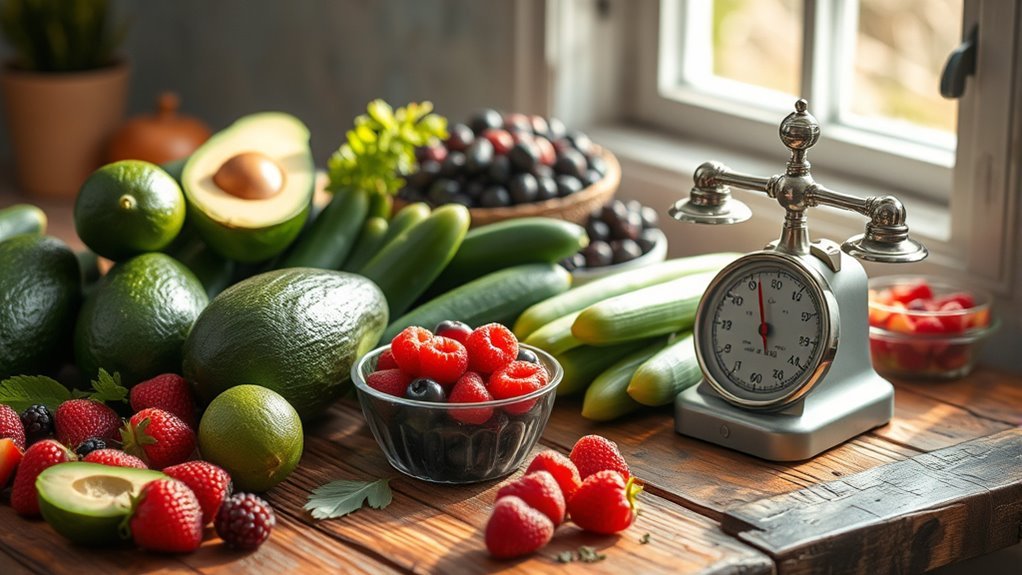On a ketogenic diet, you should limit your carbohydrate intake to about 20-50 grams per day to effectively enter and maintain ketosis. This drastically reduces your carb consumption, allowing your body to shift from using carbohydrates to fat for energy. Individual factors, like activity level and personal health goals, can influence your specific carb needs. If you want to understand how to optimize your diet further, you’re in the right place to find helpful insights.
Understanding the Basics of the Ketogenic Diet

When you commence on a ketogenic diet, understanding its fundamental principles is essential for success. The keto basics revolve around drastically reducing carbohydrate intake while increasing fat consumption. This shift encourages your body to enter a state of ketosis, where it efficiently burns fat for fuel instead of glucose. Typically, a daily carb limit of 20-50 grams is recommended to maintain ketosis, but individual tolerance may vary. Emphasizing whole foods, such as healthy fats, meats, and low-carb vegetables, aligns with the diet principles of the ketogenic approach. By mastering these essentials, you empower yourself to make informed choices, ultimately promoting freedom in your dietary journey and achieving your health goals effectively.
The Importance of Carbohydrate Restriction

Carbohydrate restriction is essential for entering and maintaining ketosis, which can greatly boost your energy levels. By lowering carbs, you also help regulate blood sugar, reducing insulin spikes and crashes. This approach not only supports weight loss but also promotes overall metabolic health.
Ketosis and Energy Levels
While many people may overlook the role of carbohydrates in their diets, understanding their impact on energy levels is essential for achieving and maintaining ketosis. When you greatly reduce carbs, your body shifts to burning fat for fuel, which can improve energy over time. However, some may experience energy dips or the keto flu during this adjustment period.
Here are three key points to reflect on:
- Fat as Fuel: Once in ketosis, fat provides a more stable energy source compared to quick-burning carbs.
- Adaptation Phase: Expect initial fatigue as your body adapts to using ketones.
- Hydration and Electrolytes: Staying hydrated and replenishing electrolytes can help mitigate energy dips and maximize your energy on keto.
Blood Sugar Regulation
Understanding how your body regulates blood sugar is essential for anyone considering a ketogenic diet. When you reduce carbohydrate intake, you minimize blood sugar spikes, allowing your body to maintain steadier glucose levels. This restriction enhances insulin sensitivity, which is important for managing energy levels and overall health. By choosing low-carb foods, you can prevent the rollercoaster of energy dips often caused by high-carb diets.
| Food | Blood Sugar Impact | Insulin Sensitivity |
|---|---|---|
| Leafy Greens | Low | High |
| Berries | Moderate | Moderate |
| Whole Grains | High | Low |
| Sugary Snacks | Very High | Low |
| Processed Foods | Very High | Low |
A stable blood sugar is key to feeling your best on keto.
Weight Loss Benefits
When you limit carbs, you’re not just changing your diet; you’re tapping into a powerful mechanism for weight loss. By restricting carbohydrates, you’re helping your body shift into ketosis, which can lead to significant benefits. Here’s how carbohydrate restriction can help you achieve weight loss and a metabolism boost:
- Fat Utilization: Your body becomes a fat-burning machine, using stored fat for energy instead of carbs.
- Appetite Control: Lower insulin levels can help reduce hunger, making it easier to stick to your calorie goals.
- Increased Energy: As your body adapts, you’ll often experience higher energy levels, allowing for more physical activity.
Embracing this approach not only aids weight loss but also empowers you with greater control over your health.
Recommended Daily Carb Intake for Keto

When following a keto diet, the standard carb limit is typically around 20 to 50 grams per day. However, individual factors like metabolism, activity level, and health goals can influence your specific needs. It is crucial to track your intake and make adjustments as necessary to stay in ketosis.
Standard Carb Limit
On a ketogenic diet, most people aim to limit their carbohydrate intake to about 20 to 50 grams per day. This restriction helps your body enter ketosis, where it burns fat for fuel instead of carbs. Here’s a quick look at standard carb limits:
- 20 grams: For strict ketosis, focusing exclusively on low-carb veggies and keto carb sources like nuts and seeds.
- 30-40 grams: For those incorporating some carb cycling, allowing a bit more flexibility on certain days.
- 50 grams: The upper limit for some, still maintaining a state of ketosis with careful planning.
Individual Variability Factors
While individuals often adhere to general carb limits on a ketogenic diet, personal factors can greatly influence the ideal intake for achieving ketosis. Your genetic predisposition, metabolic rate, and age factors can all play vital roles. Hormonal influences, particularly in women, may also affect how your body processes carbs. Additionally, your activity level and lifestyle choices dictate how many carbs you can incorporate without compromising ketosis. Health conditions and dietary preferences further tailor your carb intake. Don’t forget that stress management and sleep quality markedly impact metabolism, potentially altering your carb requirements. Understanding these individual variability factors empowers you to customize your keto journey, ensuring it aligns with your unique lifestyle and health goals.
Tracking and Adjustments
Understanding how to track your carbohydrate intake is essential for maintaining ketosis on a ketogenic diet. To optimize your results, consider these strategies for tracking and making necessary adjustments:
- Set a Daily Carb Limit: Aim for 20-50 grams of net carbs daily, depending on your individual needs.
- Incorporate Macro Adjustments: Regularly evaluate your macronutrient ratios to guarantee you’re meeting your fat, protein, and carb goals.
- Experiment with Carb Cycling: Occasionally adjusting your carb intake can help prevent plateaus and enhance metabolic flexibility.
Factors Influencing Individual Carb Needs
Since each person’s body responds differently to carbohydrate intake, several factors can influence your individual carb needs on a keto diet. Understanding these influences can help you tailor your approach for best results.
| Factor | Description | Impact on Carbs |
|---|---|---|
| Lifestyle Factors | Your daily routine and habits | Determines carb tolerance |
| Activity Level | How active you are during the day | Higher activity may need more carbs |
| Age Considerations | Your age can affect metabolism | Older adults may need fewer carbs |
Other considerations include your metabolic rate, health conditions, personal goals, food preferences, and nutrient timing. By factoring in these elements, you can find the right carb intake that aligns with your unique needs and aspirations.
The Role of Ketosis in Fat Loss
When you enter ketosis, your body shifts from relying on carbohydrates for energy to burning fat, which can greatly enhance fat loss. This metabolic change activates ketosis mechanisms that promote fat adaptation, allowing your body to efficiently utilize fat stores for energy. Here are three key benefits of being in ketosis:
- Increased Fat Oxidation: Your body becomes proficient at converting fat into ketones, which serve as an energy source.
- Reduced Hunger: Ketosis can lead to decreased appetite, making it easier to maintain a calorie deficit.
- Stable Energy Levels: You’ll experience more consistent energy throughout the day, reducing the energy crashes often associated with carb-heavy diets.
How to Track Your Carb Intake
Tracking your carb intake is essential for maintaining ketosis. You can use tracking apps for convenience, or opt for manual food journaling if you prefer a hands-on approach. Both methods can help you stay accountable and guarantee you meet your daily carb limits.
Use Tracking Apps
To effectively manage your carbohydrate intake on a keto diet, using tracking apps can be a game changer. These apps help you stay on top of your goals and tackle common tracking challenges. Here are some app recommendations to take into account:
- MyFitnessPal: Offers a vast food database for easy carb tracking.
- Carb Manager: Specifically designed for keto, it helps you monitor net carbs and macros.
- Cronometer: Provides detailed nutritional information, ensuring you meet your dietary needs.
Manual Food Journaling
While many find digital tracking convenient, manual food journaling offers a tangible way to monitor your carb intake on a keto diet. By jotting down what you eat, you engage in manual tracking, which enhances food awareness. You’ll start noticing patterns in your eating habits, helping you identify high-carb foods that may derail your progress. Journaling benefits include improved focus on your goals and the chance to reflect on your choices. This method serves as a powerful accountability tool, keeping you committed to your keto lifestyle. Plus, it creates a personal record of your journey, allowing for adjustments as you learn what works best for your body. Embrace this hands-on approach for greater freedom in your dietary choices.
Common Mistakes to Avoid on Keto
Although many people find success on the keto diet, several common mistakes can hinder progress and lead to frustration. Understanding keto misconceptions is crucial to avoid these common pitfalls:
- Not Tracking Macros: Failing to monitor your carb intake can result in exceeding your daily limits, which stalls ketosis.
- Overlooking Hidden Carbs: Many foods contain unexpected carbs; sauces, dressings, and even vegetables can sabotage your efforts.
- Neglecting Nutritional Balance: Focusing solely on fat while ignoring protein and essential nutrients can lead to deficiencies and decreased energy levels.
Adjusting Carb Intake for Different Goals
Adjusting your carb intake on the keto diet can be vital for reaching specific health and fitness goals. For instance, if you’re focusing on muscle maintenance or performance enhancement, carb cycling might be beneficial. This strategy allows you to consume higher carbs on training days, aligning with your energy requirements, while reducing them on rest days to promote metabolic adaptation. Effective goal setting is important here; knowing whether you’re aiming for weight loss, muscle gain, or endurance can guide your carb adjustments. Keep in mind that individual responses vary, so monitor how these changes affect your energy levels and overall well-being. By fine-tuning your carb intake, you can enjoy the flexibility of the keto diet while still working toward your objectives.
Foods to Include and Avoid on a Keto Diet
When commencing on a keto diet, knowing which foods to include and avoid is essential for maintaining ketosis and achieving your health goals. Focus on incorporating keto-friendly snacks and healthy fats into your meals. Here’s a quick list to guide you:
- Include: Avocados, olive oil, and nuts. These are excellent sources of healthy fats.
- Avoid: Sugary foods, grains, and starchy vegetables. They can spike your carb intake and disrupt ketosis.
- Moderate: Dairy products and fruits. While some can fit in your diet, be cautious with portions.
Tips for Staying on Track With Your Carb Limits
Staying on track with your carb limits can be challenging, but implementing a few practical strategies can make a significant difference. Start with meal planning and meal prepping to guarantee you’ve got low-carb options ready. Explore healthy snack options to avoid temptation, and remember to stay hydrated—water can help curb cravings. When dining out, check menus ahead of time and practice portion control to keep your carb intake in check. Use motivational strategies like setting achievable goals to stay inspired. In social situations, don’t hesitate to bring your own food or suggest restaurants with keto-friendly choices. Finally, always keep a list handy for grocery shopping to avoid impulse buys that could derail your progress.


